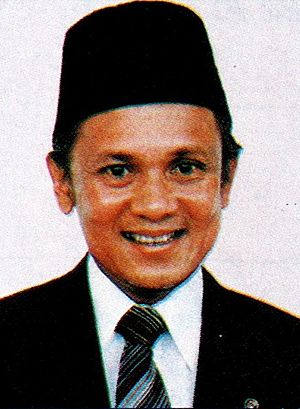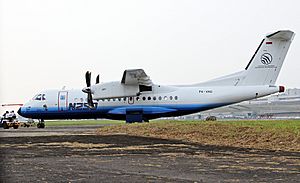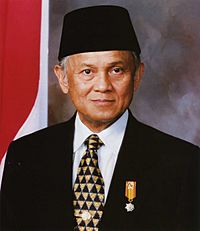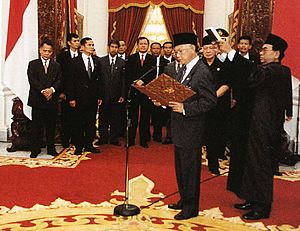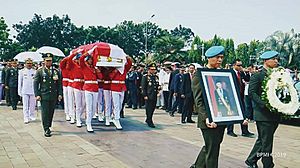B. J. Habibie facts for kids
Quick facts for kids
B. J. Habibie
|
|
|---|---|
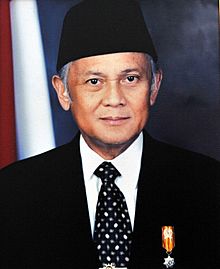
Official portrait, 1998
|
|
| 3rd President of Indonesia | |
| In office 21 May 1998 – 20 October 1999 |
|
| Vice President | Vacant |
| Preceded by | Suharto |
| Succeeded by | Abdurrahman Wahid |
| 7th Vice President of Indonesia | |
| In office 11 March 1998 – 21 May 1998 |
|
| President | Suharto |
| Preceded by | Try Sutrisno |
| Succeeded by | Megawati Sukarnoputri |
| 4th Minister of Research and Technology | |
| In office 29 March 1978 – 16 March 1998 |
|
| President | Suharto |
| Preceded by | Sumitro Djojohadikusumo |
| Succeeded by | Rahardi Ramelan |
| Personal details | |
| Born |
Bacharuddin Jusuf Habibie
25 June 1936 Parepare Afdeling, Dutch East Indies |
| Died | 11 September 2019 (aged 83) Jakarta, Indonesia |
| Resting place | Kalibata Heroes Cemetery |
| Political party | Golkar |
| Spouse |
Hasri Ainun Besari
(m. 1962; died 2010) |
| Children |
|
| Parents |
|
| Alma mater | ITB RWTH (Dipl.Ing.) RWTH (Dr. Ing.) |
| Occupation |
|
| Signature |  |
Bacharuddin Jusuf Habibie (born 25 June 1936 – died 11 September 2019) was an Indonesian engineer and politician. He became the third president of Indonesia from 1998 to 1999. He was also the seventh vice president for a short time before becoming president.
Habibie became president after Suharto resigned in 1998. His time as president was important because it marked a big change for Indonesia. He made the press more free and allowed more political parties. He also held a democratic election earlier than planned, which led to the end of his presidency. His time as president and vice president was the shortest in Indonesia's history.
Contents
Early Life and Family
Habibie was born in Parepare, a city in South Sulawesi, Indonesia. His family had roots from different parts of Indonesia, including Bugis, Gorontalese, and Javanese backgrounds. His father, Alwi Abdul Jalil Habibie, was an agriculturist, and his mother, R. A. Tuti Marini Puspowardojo, was from a noble Javanese family.
Habibie was the fourth of eight children. Sadly, his father passed away when Habibie was only 14 years old. In 2018, a monument was built in his honor near Djalaluddin Airport in Gorontalo Regency.
Education and Engineering Career
Habibie was a very bright student. He first went to the Netherlands to study aviation and aerospace. However, due to political issues between the Netherlands and Indonesia, he moved to RWTH Aachen University in Aachen, Germany to continue his studies.
In 1960, Habibie earned his engineering degree in Germany. He stayed there to do more research for his doctoral degree. He later received his doctorate in aerospace engineering in 1965 with excellent marks.
Habibie worked for a railway company and later for Messerschmitt-Bölkow-Blohm in Hamburg. This company was involved in developing the Airbus A-300 aircraft. During his time there, he developed important theories about how things fly and are built, known as the Habibie Factor, Habibie Theorem, and Habibie Method. He became a vice president at the company in 1974.
In 1974, Indonesia's president, Suharto, asked Habibie to return to Indonesia. Suharto wanted Habibie to help industrialize and develop the country. Habibie became a special assistant and later the CEO of a new state-owned company called Industri Pesawat Terbang Nurtanio (IPTN). This company, now known as Indonesian Aerospace, builds aircraft.
Under Habibie's leadership, IPTN grew a lot. It started making helicopters and small passenger planes. One of its most famous projects was the N-250 Gatotkaca, a small passenger airplane. Habibie also created programs like OFP, STMDP, and STAID. These programs gave scholarships to thousands of young Indonesians to study science, technology, engineering, and math (STEM) in other countries.
Political Journey
Minister of Research and Technology (1978–1998)
In 1978, Habibie became the State Minister of Research and Technology. In this role, he continued to lead important industries, especially in aircraft manufacturing. By the 1980s, IPTN was making helicopters and planes like the CASA planes.
Habibie also became a member of the Golkar political organization. He was elected as the first leader of the Indonesian Association of Muslim Intellectuals (ICMI) in 1990. This group gave him a strong political base.
Vice Presidency (1998)
In early 1998, President Suharto hinted that Habibie would be his choice for vice president. Despite some concerns due to the Asian Financial Crisis at the time, Habibie was elected as vice president in March 1998.
Presidency (1998–1999)
Just two months after becoming vice president, Suharto resigned on 21 May 1998. According to the Constitution, Habibie then became president. He quickly formed a new cabinet and made several important changes. He asked his family members to step down from government jobs and promised to hold early elections. He also made the press more free and released some political prisoners.
East Timor's Future
Habibie decided to offer East Timor a special choice for its future. For a long time, people in East Timor had been asking for a vote on whether to become independent from Indonesia. Habibie surprised many by announcing that a referendum would be held. In this vote, the people of East Timor could choose between having special self-rule or becoming fully independent.
On 30 August 1999, the referendum took place. The people of East Timor voted overwhelmingly for independence. After this, there was a period of violence and many people had to leave their homes. On 12 September, Habibie agreed to allow a UN peacekeeping force to help stop the violence. East Timor later became an independent country in May 2002.
Political Changes
Under Habibie, Indonesia made big changes to its political system. These changes allowed for more competition and freedom of speech. Soon after becoming president, in June 1998, his government removed old rules that limited political parties. They also ended censorship by closing the Information Ministry.
He quickly promised to hold democratic elections. In December, new laws were passed that set elections for December 1999. These laws also reduced the number of seats in parliament held by the military. Habibie's government also passed laws that gave more power to local governments in different regions and cities.
End of Presidency
Habibie wanted to continue as president, but he faced challenges. His political party, Golkar, had different groups with different ideas. In October 1999, Habibie gave a speech about his time as president. The members of the People's Consultative Assembly (MPR) then voted on whether to accept his speech. His speech was rejected, which meant he could not continue as president. He then withdrew his nomination. Abdurrahman Wahid became the next president.
Life After Presidency
After his presidency, Habibie spent more time in Germany. He also continued to be active in Indonesia as an adviser to President Susilo Bambang Yudhoyono. During this time, he started the Habibie Centre, which is a group that studies important issues.
In September 2006, he wrote a book called Detik-Detik Yang Menentukan: Jalan Panjang Indonesia Menuju Demokrasi (Decisive Moments: Indonesia's Long Road Towards Democracy). This book shared his memories of the events in May 1998 when he became president.
Passing Away
In September 2019, Habibie was admitted to the hospital for heart problems. He passed away on 11 September 2019. He was buried at the Kalibata Heroes Cemetery in Jakarta, next to his wife's grave.
After his death, the Indonesian government announced a three-day period of national mourning. The Indonesian flag was flown at half-staff during this time. Many people, including former President of East Timor, Xanana Gusmão, shared their sadness and respect for Habibie.
Family Life
Habibie was married to Hasri Ainun Besari, who was a medical doctor. They were married on 12 May 1962, and she passed away on 22 May 2010. They had two sons, Ilham Akbar Habibie and Thareq Kemal Habibie.
After his wife's death, Habibie wrote a book called Habibie & Ainun. The book shared the story of his relationship with his wife. This book was later made into a popular film in 2012.
Awards and Honors
Habibie received many awards and honorary degrees for his important work in technology and science. For example, he received honorary degrees from universities in the United Kingdom, South Korea, and Indonesia.
He was also made an honorary member of several important engineering and aviation groups around the world, including:
- Malaysian Engineers Association (IEM)
- Japanese Academy of Engineering
- Royal Academy of Engineering, UK
- National Academy of Engineering, USA
- Royal Aeronautical Society, UK
- Royal Swedish Academy of Engineering Science
- American Institute of Aeronautics and Astronautics, USA
As a vice president and president of Indonesia, he automatically received the highest national awards from Indonesia. He also received special honors from other countries, such as:
 Grand Cross of the Order of Leopold II (Belgium)
Grand Cross of the Order of Leopold II (Belgium) Grand Cross of Aeronautical Merit (Chile)
Grand Cross of Aeronautical Merit (Chile) Grand Officer of the Legion of Honour (France)
Grand Officer of the Legion of Honour (France) Grand Cross 1st Class of the Order of Merit of the Federal Republic of Germany (Germany)
Grand Cross 1st Class of the Order of Merit of the Federal Republic of Germany (Germany) Knight Grand Cross of the Order of Merit of the Italian Republic (Italy)
Knight Grand Cross of the Order of Merit of the Italian Republic (Italy) Grand Cordon of the Order of Independence (Jordan)
Grand Cordon of the Order of Independence (Jordan) Knight Grand Cross of the Order of Orange-Nassau (Netherlands)
Knight Grand Cross of the Order of Orange-Nassau (Netherlands) Grand Cross of the Order of Civil Merit (Spain)
Grand Cross of the Order of Civil Merit (Spain) Grand Cordon of the Order of Brilliant Star (Taiwan)
Grand Cordon of the Order of Brilliant Star (Taiwan)
Places Named After Him
Several places, especially in Sulawesi where he was from, are named in his honor:
- In Parepare, there is a monument called Monumen Cinta Sejati Habibie Ainun (Habibie Ainun True Love Monument).
- The Gelora Mandiri Stadium in Parepare was renamed Gelora B.J. Habibie Stadium.
- His former house in Parepare has been turned into a presidential museum.
- The B.J. Habibie Floating Mosque in Parepare was opened in 2022.
- In Gorontalo Regency, there is a monument of Habibie near Jalaluddin Airport.
- Timor-Leste named a bridge and a park in Dili after him.
Images for kids
See also
 In Spanish: Jusuf Habibie para niños
In Spanish: Jusuf Habibie para niños


